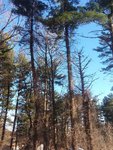First off, I'm of the opinion trees are best left alone, and are best equipped to take care of themselves. However, on my project at work, I want to deadwood the white pines(pinus strobus), and take the dead vines down. It would really make it look nice, cause it's one the main things you see coming down the driveway. It'll also give me a lot of quality time on the ropewrench+foot ascender on straight up/down work. Most of it is pretty straight forward with the routine couple inch sticks poking out here and there. Main question incoming...
There is one beefy stub though, and I'm wondering if it would be best to just leave it there. I'm eyeballing it from the ground, but I'd say it's 8"-10"dia, on perhaps a 16" stem. It might be 2.5' long starting laterally(ish) for ~1', then growing up to a broken point. Options I'm considering...
Do nothing. Let it keep its imperfect, but natural looking shape
Cut it, but leave a substantial stub to allow the tree to work with it. Maybe take off the vertical component.
Cut it at the collar, and let the tree handle it from there.
My main concern with a collar cut is it'll leave a large wound that'll be more likely to allow rot and bugs to get in. Nobody told me to do any of this. It's all at my discretion, and I want it to look nice, and not cause lasting damage. It's also some fun for me, cause that's what I'm considering my pay to be. I'm pretty certain I won't even get enough money to cover my burned up brushcutter.
Possibly useful info... Conifers don't seem to be doing great around here, particularly spruces. A lot of the white pines on this property have died and fallen over. Wikipedia says their lifespan can go into hundreds of years, and none of these are anywhere close to that. That indicates to me something is particularly attacking them, but perhaps this is the usual attrition rate :shrugs:
There is one beefy stub though, and I'm wondering if it would be best to just leave it there. I'm eyeballing it from the ground, but I'd say it's 8"-10"dia, on perhaps a 16" stem. It might be 2.5' long starting laterally(ish) for ~1', then growing up to a broken point. Options I'm considering...
Do nothing. Let it keep its imperfect, but natural looking shape
Cut it, but leave a substantial stub to allow the tree to work with it. Maybe take off the vertical component.
Cut it at the collar, and let the tree handle it from there.
My main concern with a collar cut is it'll leave a large wound that'll be more likely to allow rot and bugs to get in. Nobody told me to do any of this. It's all at my discretion, and I want it to look nice, and not cause lasting damage. It's also some fun for me, cause that's what I'm considering my pay to be. I'm pretty certain I won't even get enough money to cover my burned up brushcutter.
Possibly useful info... Conifers don't seem to be doing great around here, particularly spruces. A lot of the white pines on this property have died and fallen over. Wikipedia says their lifespan can go into hundreds of years, and none of these are anywhere close to that. That indicates to me something is particularly attacking them, but perhaps this is the usual attrition rate :shrugs:



